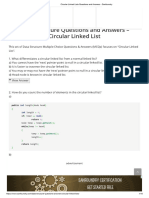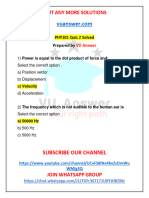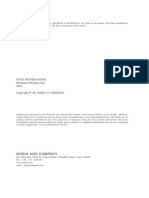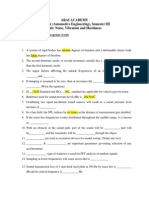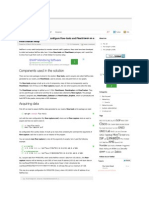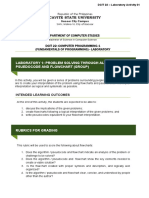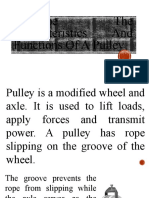AE 688 Dynamics And Vibration
Assignment No. 6
Single Degree Freedom Free and Forced Vibrations
1. Figure 2.11 shows a simple pendulum attached to a spring of stiffness k ,
a) obtain the differential equation of motion for the system
b) determine the natural frequency of oscillation.
2. Figure 2.14 shows a pendulum were the weight of the connecting rod is W R and the
weight of the pendulum bob is WB . Obtain
a) the differential equation of motion
b) the natural frequency
c) the period of small oscillations of the pendulum
3. A massless cantilever beam PQ of length L fixed at P and fastened to a spring k and a
mass M at Q.
1
�a) obtain the differential equation of motion for a small vertical motion of M
b) find an expression for the frequency of oscillation.
The configuration is shown in Fig.2.9
4. A uniform bar pivoted at point M resting on springs of equal stiffness k at each end as
shown in Fig.2.12.
a) obtain the differential equation of motion
b) determine the natural frequency of oscillation.
5. Figure 2.17 shows a torsional vibration system in which the disk having a mass
moment of inertia about its axis I G is fastened to shafts of different d 1 and d 2 and the
shafts are fixed at both ends. Obtain
a) the differential equation of angular motion
b) the natural frequency of angular vibration.
�6. Figure 2.15 shows a U-tube manometer used for measuring gas or liquid pressure.
The cross-sectional area of the manometer is A, the total length of the column of
liquid is l, and the density of the liquid or gas is . The viscosity of the liquid or gas
is negligible. Obtain
a) the differential equation of motion for the U-tube manometer
b) the period of oscillation
7. Fig. 2.16 shows a uniform rigid disk of radius r rolls without shipping inside a
circular track of radius R. Obtain
a) the differential equation of motion for the system
b) the natural frequency of the system
�8. Determine the natural frequency of angular oscillations of the simple pendulum
shown in Fig.2.18 if
a) the mass of the rod m r is negligible
b) the mass of the rod m r is not negligible
9. Determine an expression for the natural frequency of the system shown in Figure
2.22 using the energy method.
10. Determine the steady state response of the system shown in Fig.3.8. The uniform
bar has a length of l , mass m and is pinned at point O. The stiffness of the linear
spring is k. The bar is subjected to the moment = 0 sin t as shown.
�11. Figure 2.29 shows a semi-circular shell of mass M and radius R rolling from side
to side without slipping. Use the energy method to determine the natural frequency of
vibration of the system.
12. Figure 2.31 shows the mass M hanging from a cord attached to the homogeneous
circular disk of mass m and radius r. To restrain the disc from rotating, a spring of
linear stiffness k is attached at a radius b from the discs center. Determine the natural
frequency of oscillation of the system when the mass is displaced downward from the
equilibrium position.
�13. A uniform cylinder of mass m and radius r rolls without slipping as shown in
Fig.3.10. Determine
a) the differential equation of motion
b) the frequency of free vibration.
14. Determine the natural frequency of oscillation for small displacements of a
semicircular homogeneous disk of radius r and mass pivoted at its center O as shown in
Fig.2.23.
15. For a single degree of freedom forced undamped system, k = 50 lb/in, m = 0.2 lbs2/in,
and F = 15 lb. The forcing function has a circular frequency of 19.76 rad/sac. The initial
conditions are x(0) = 2 inches and x& (0) = 1 in/sec. Determine
6
�a) the frequency ratio
b) the amplitude of the forced response
c) the displacement at t = 5 seconds.
16. A single degree of freedom damped spring mass system has a weight of 20 lb, spring
stiffness of 50 lb/in, and damping coefficient of 3.94 lb s/in is subjected to a harmonic
force F = 100 sin 12.692t lb. The initial conditions are given as x(0) = 1.5 in
and x& (0) = 0 . Obtain an equation that describes the displacement of the mass as a
function of time.
17. An electromechanical machine system weighing 25 lbs is subjected to a harmonic
excitation having a minimum value of 15 labs and a frequency of 200 cycles/min. Design
an appropriate lightly damped spring mass support system for this machine such that the
machine dose not collide in its movement given that the clearance for the vibrational
displacement or the clearance of the machine is 1.5 in.
18. For an undamped single degree of freedom spring mass system, m = 10 kg, k = 500
N/m, F0 = 40 N and the forcing frequency = 18 rad/s. The initial conditions are
x(0) = 0.01 m and x& (0) = 1 m/s. Determine
a) the frequency ratio
b) the displacement of the mass at t = 1 sec.







